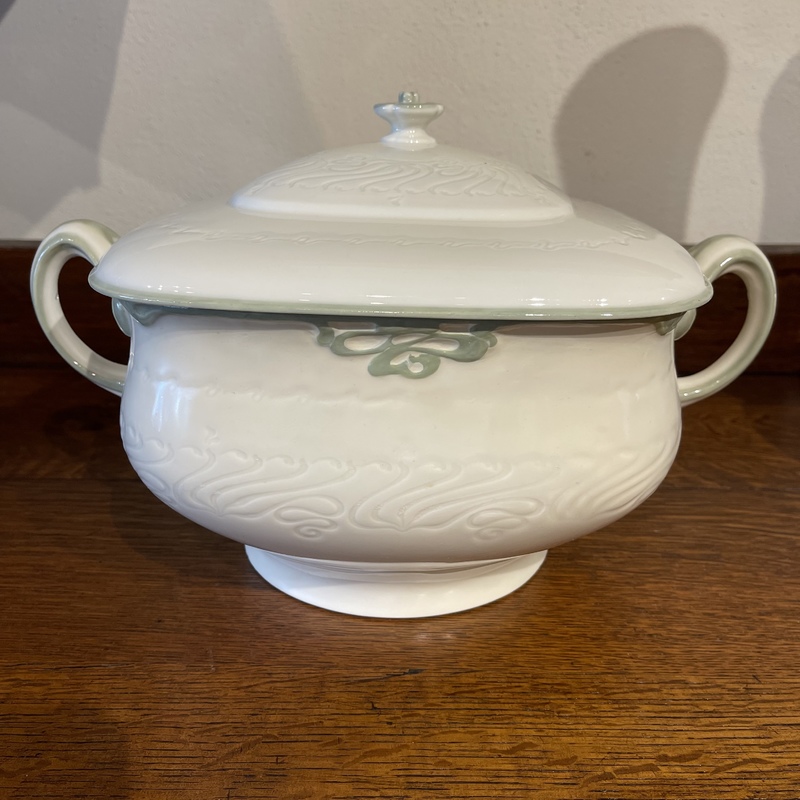Covered Tureen in the "Canton" Pattern
Item
Title
Covered Tureen in the "Canton" Pattern
Creator
Edward Colonna (des.)
Gérard, Dufraisseix & Abbot (maker)
Siegfried Bing (retailer)
Gérard, Dufraisseix & Abbot (maker)
Siegfried Bing (retailer)
Date
1902 (ca.)
Dimensions
8 x 13 x 9 1/2 inches
Medium
Glazed porcelain
Credit line
Collection of The Gustav Stickley House Foundation, gift of Christopher and Renee Wiles
Description
Stickley's purchase of Colonna-designed china from Bing's shop was extensive, and a number of specialized forms–from plates, to bowls, to soup tureens, to small covered dishes–descended through his family. A small selection of these items is included in this exhibition because Stickley's purchase of this pattern, the exhibition of examples at the 1903 Arts and Crafts exhibition in Syracuse, and the sustained ownership and eventual descent through the family suggests that they were important to him and formed part of the visual ecosystem of taste that is at the core of this exhibit.
About the Designer:
Edward Colonna's life and career put him at the center of the design world at the turn of the twentieth century and associated him with luminaries like Louis Comfort Tiffany, Siegfried Bing, and Mary Louise McLaughlin. Born Edouard Klonne on May 27, 1862 in Mulheim, Germany he emigrated to the United States in November 1882, sailing from Amsterdam. Having studied architecture from 1877-81 in Brussels, he quickly found work in New York, first for Louis Comfort Tiffany in 1883 and later for architect Bruce Price from 1884-5. He moved to Dayton, Ohio in 1885 where he worked for Barney & Smith and married the niece of ceramist Mary Louise McLaughlin. He apparently moved to Canada in 1888, though on November 13th of that year he was living in New York City and successfully applied for naturalization, a process that had taken him three years.
Following his time in Canada, Colonna moved to Europe in 1898 and was associated with Siegfried Bing’s L’Art Nouveau through 1903, when he returned to the United States. The following year, in October, he was in Berlin where he applied for a passport for himself and his wife Grace. Although in 1908, when he applied to live abroad for two years, he claimed he had resided in the United States uninterrupted for the past twenty-five years, this testimony oversimplified his travels and ignored large parts of his career. From 1913, when he reportedly returned to the United States, Colonna resided in New York City and for the next decade was apparently engaged in various occupations including interior designer and antiques dealer. By 1920, he listed himself in the Federal Census as an “Expert, Real Estate.”
On August 18, 1923 Colonna applied for a passport with the intention of leaving from Providence, Rhode Island on September 11 of that year for France to improve his paralyzed state. He settled in Nice in 1925 and worked intermittently, as his health allowed, until his death in 1948.
About the Designer:
Edward Colonna's life and career put him at the center of the design world at the turn of the twentieth century and associated him with luminaries like Louis Comfort Tiffany, Siegfried Bing, and Mary Louise McLaughlin. Born Edouard Klonne on May 27, 1862 in Mulheim, Germany he emigrated to the United States in November 1882, sailing from Amsterdam. Having studied architecture from 1877-81 in Brussels, he quickly found work in New York, first for Louis Comfort Tiffany in 1883 and later for architect Bruce Price from 1884-5. He moved to Dayton, Ohio in 1885 where he worked for Barney & Smith and married the niece of ceramist Mary Louise McLaughlin. He apparently moved to Canada in 1888, though on November 13th of that year he was living in New York City and successfully applied for naturalization, a process that had taken him three years.
Following his time in Canada, Colonna moved to Europe in 1898 and was associated with Siegfried Bing’s L’Art Nouveau through 1903, when he returned to the United States. The following year, in October, he was in Berlin where he applied for a passport for himself and his wife Grace. Although in 1908, when he applied to live abroad for two years, he claimed he had resided in the United States uninterrupted for the past twenty-five years, this testimony oversimplified his travels and ignored large parts of his career. From 1913, when he reportedly returned to the United States, Colonna resided in New York City and for the next decade was apparently engaged in various occupations including interior designer and antiques dealer. By 1920, he listed himself in the Federal Census as an “Expert, Real Estate.”
On August 18, 1923 Colonna applied for a passport with the intention of leaving from Providence, Rhode Island on September 11 of that year for France to improve his paralyzed state. He settled in Nice in 1925 and worked intermittently, as his health allowed, until his death in 1948.
